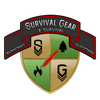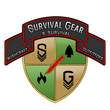The Anatomy of Bushcraft Knives

While there is a decent amount of variation in survival or bushcraft knives, these tools share basic anatomy. In order to properly discuss these knives, it is important to be familiar with certain terminology regarding bushcraft knife anatomy. Most of these terms are labeled in the diagram above.
Anatomy of a Bushcraft Knife:
The Blade
The first, and perhaps most obvious, part is the blade. Typically, the blade consists of the cutting edge on one side and the spine on the other. The blade is the most important part of a bushcraft knife considering it is the part that cuts.
It can be made from many different types of material, but the best are made from metal.
Metals
The best bushcraft knives generally wield blades made from steel. Technically, steel is an alloy of iron-- meaning that additional elements are added to increase the strength of the metal. These additives usually consist of carbon and/or chromium. Not only do additives, like carbon and chromium, affect the strength of the metal, they can affect the type of steel that is crafted. Most steels that are used in crafting bushcraft blades can be classified as either Stainless or Carbon.
Types of Steel:
-
Stainless Steel
This metal is created with the additive of chromium, which typically makes up around 12% of the blade. This relatively high percentage of chromium creates a strong oxide layer, which slows down the oxidation process and, thus, corrosion. Though stainless steel isn’t truly “stainless,” it corrodes at a much slower rate than other metals.
Stainless steel blades are ideal for when you find yourself in environments that don’t allow for much time to care for high maintenance knives, like on a kayaking trip or fishing trip. Thanks to stainless steel’s resistance to corrosion, these types of bushcraft knives are great for cleaning game.
-
Carbon Steel
Thanks to the increased percentage of carbon (usually around 1.5%) in this type of steel, it is incredibly durable. Carbon steel blades, however, require conscientious maintenance with regular sharpening, honing, and oiling. Though they require more care, carbon steel blades are often much stronger and sharper than stainless steel blades. Despite being high maintenance, carbon steel is the favorite blade material of many expert bushrangers.
Bevel or Grind
When sharpening your blade, your focus will be on the bevel. The bevel, or grind, is the section of the blade that forms the cutting edge.
Some knives have serrations on the bevel. This is especially useful when sawing through materials like rope.
Spine
The back of the blade, opposite the bevel, is the spine. This is the area used to measure the thickness of the blade.
Handle
Another fairly obvious part of every knife is the handle. This is the part of the knife that you hold. Oftentimes, there are guards that form a type of lip under the blade to help prevent you from accidentally cutting yourself.
Handles can be made out of a multitude of materials, such as:
- Metals
- Stainless steel
- Aluminum
- Titanium
- Synthetic Blends
- G-10
- Carbon fiber
- Paracord
- Natural Substances
- Bone
- Wood
- Leather
Tang
The dictionary definition of tang is: “the projection on the blade of a tool such as a knife, by which the blade is held firmly in the handle.”
The diagram above shows a full tang. With full tang knives, the handle merely covers the metal. This means that the metal extends through the handle and causes the knife to be able to handle more aggressive exertions, like hammering. Hammering and similar applications are not advisable to perform with a partial tang knife.
In addition to the full and partial tang types, there are multiple styles of tangs. Some of these styles require rivets to hold the metal within the handle in place. Common full tang styles include:
- Scaled
- Encapsulated
- Extended
- Stick
- Hidden
- Skeletonized
- Tapered
- Push
Pommel or Butt
Though not labeled in the above diagram, the pommel- also known as the butt- is opposite the “point.” The butt is the end of the knife, the bottom part of the handle.
The butt of the knife adds a striking and hammering function. Though this function may be limited, the butt of the knife can be used to break glass, if necessary. For hammering purposes, the wider the butt, the more impactful it will be.
Drop Point
The curving portion of the knife’s spine to the tip of the cutting edge’s point is called the drop point. This is a unique feature of bushcraft knives, which provides them with their praised spearhead-like shape.
Sheath
A sheath is a cover for a blade. Though it is not a physical part of the knife’s anatomy, sheaths are essential to bushcraft knives. Due to the generally large size of these knives, it is not likely that you will be able to carry a bushcraft knife in your pocket. Additionally, when carrying a bushcraft knife, there is usually a need to have it be easily accessible (again, not in a pocket).
Thus, most sheaths are able to be mounted on the belt or hip. Some sheaths can also be mounted on the shoulder, chest, or thigh.







Leave a comment